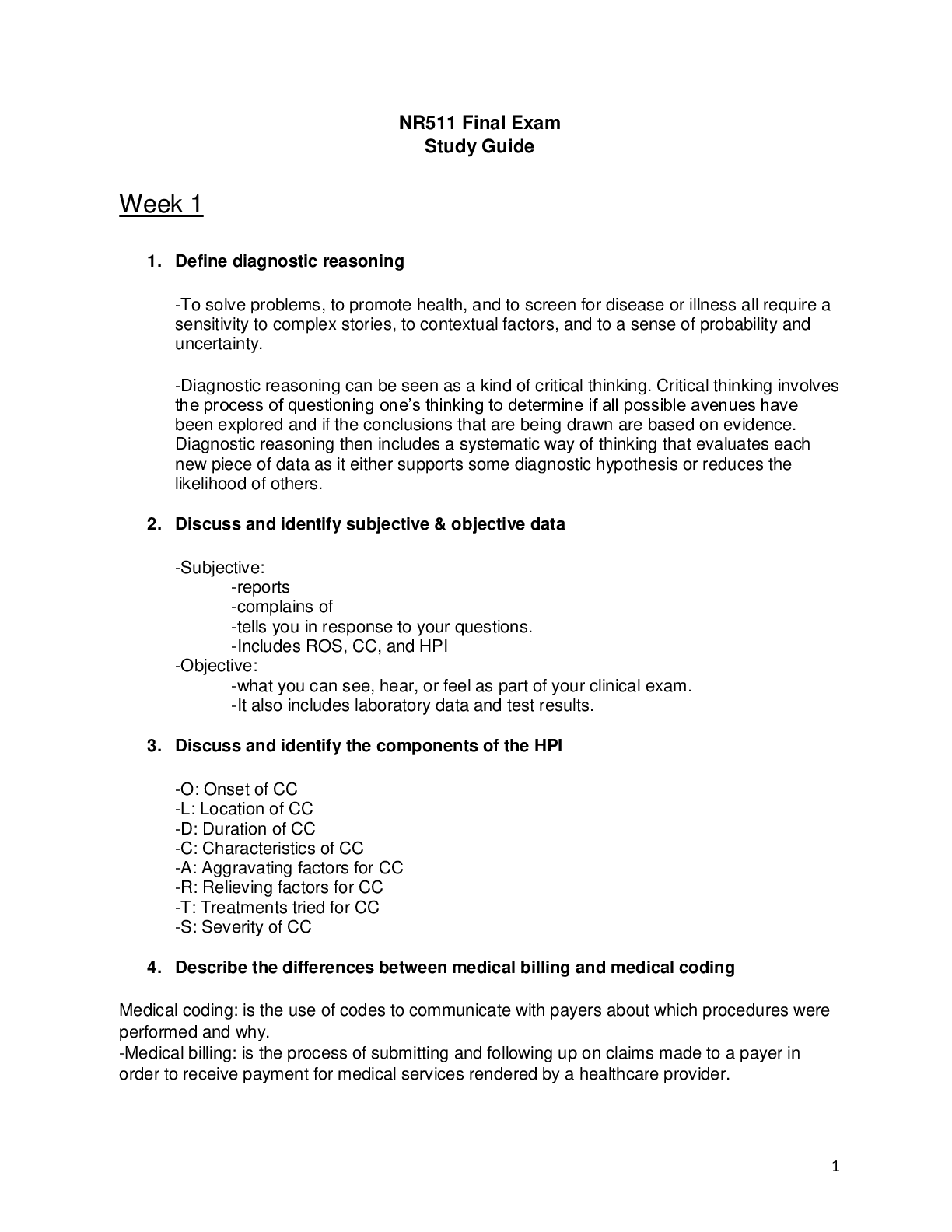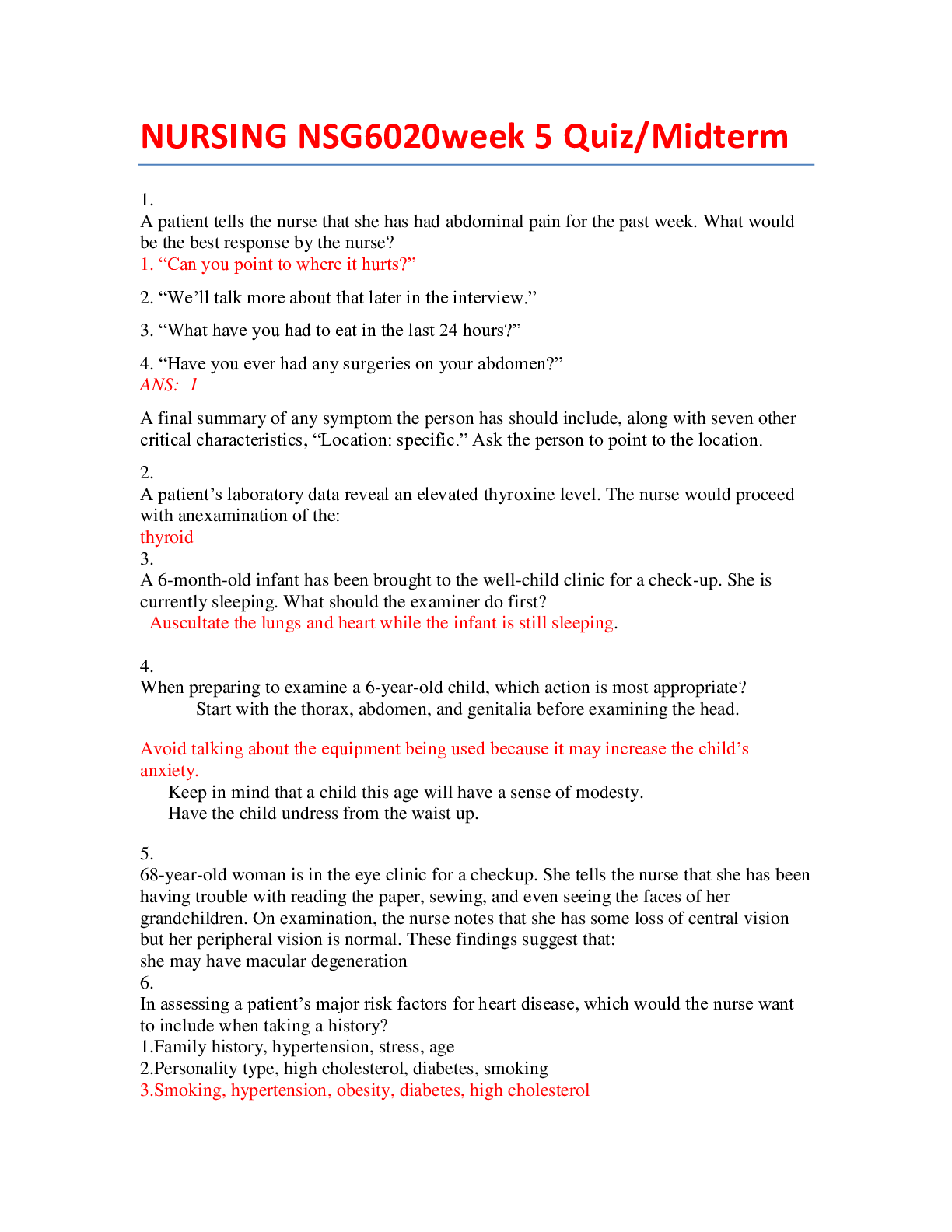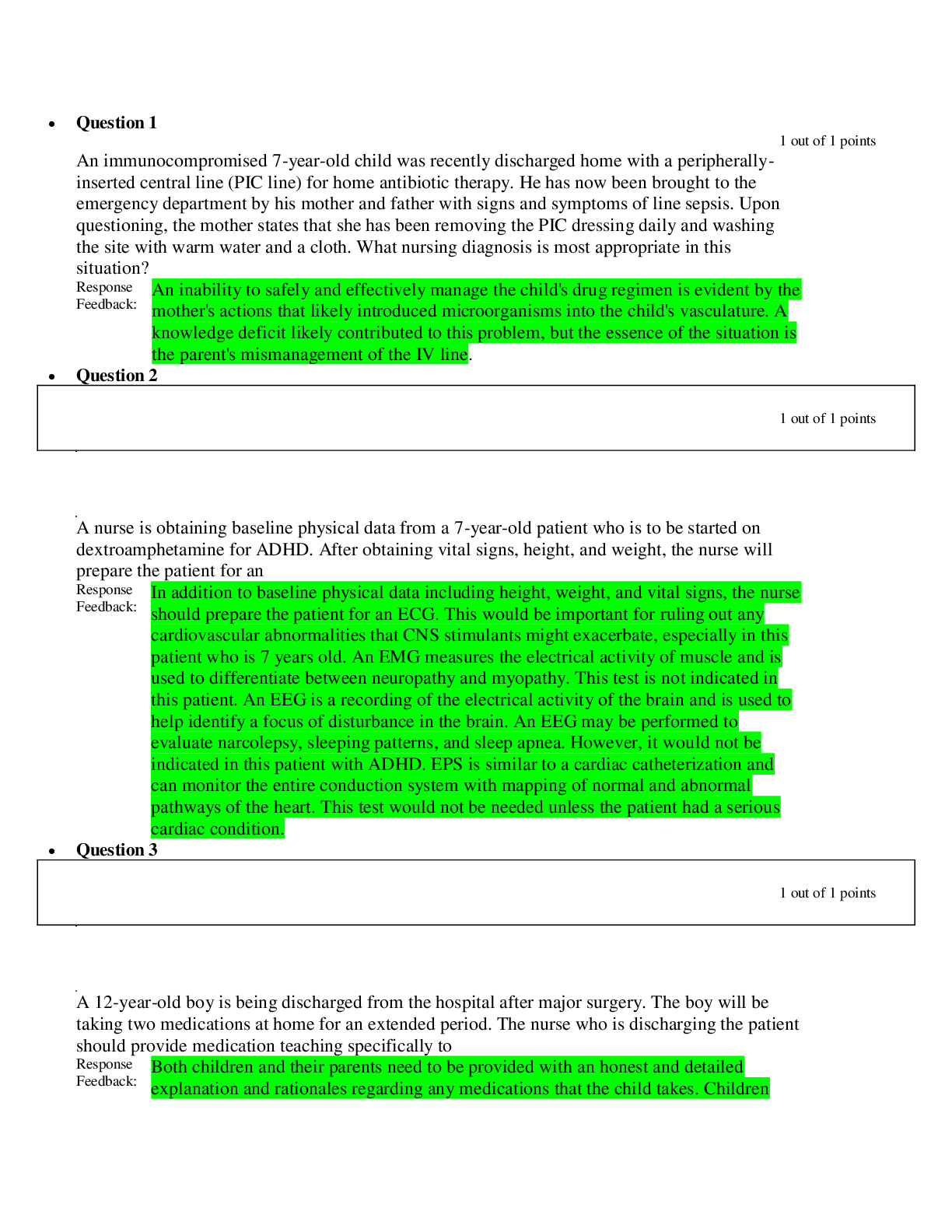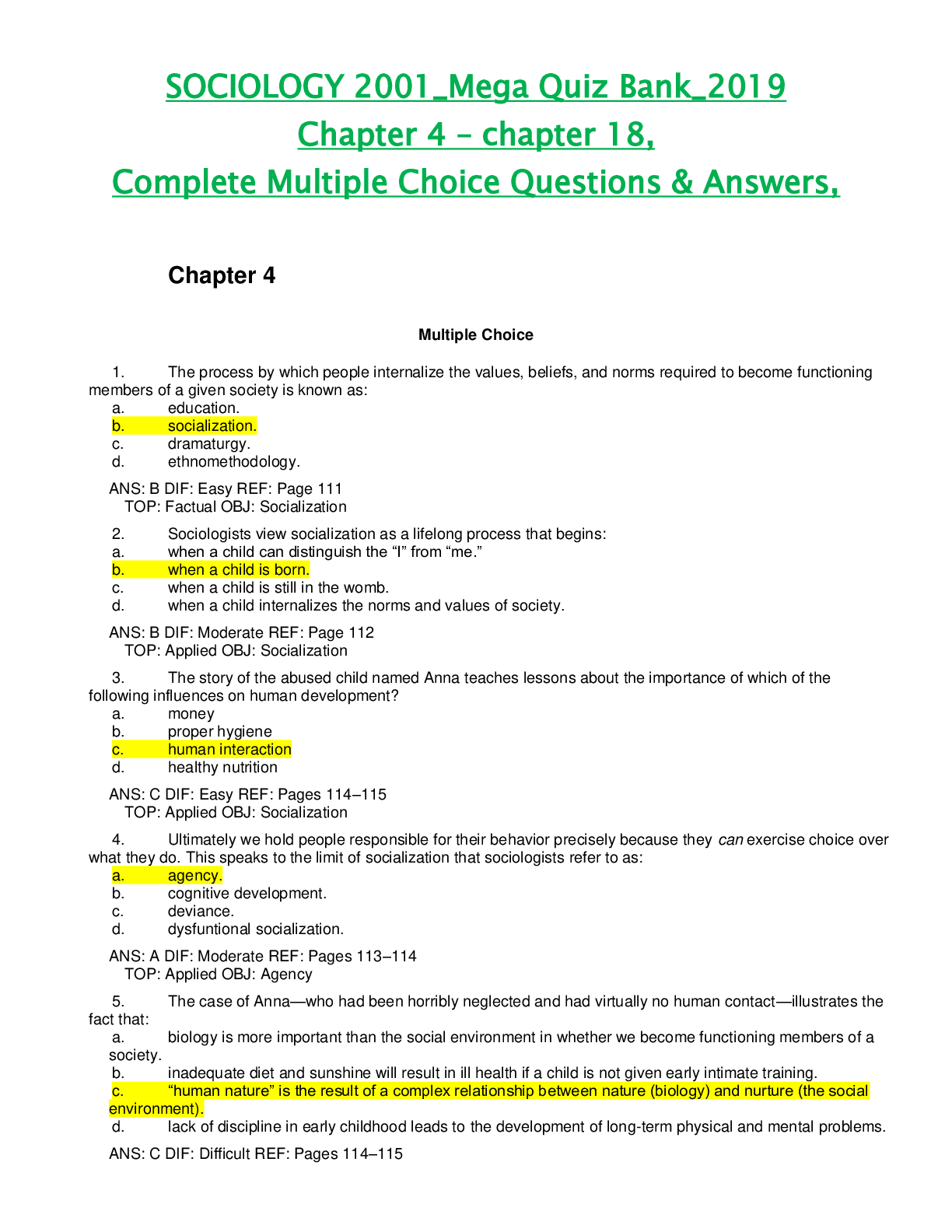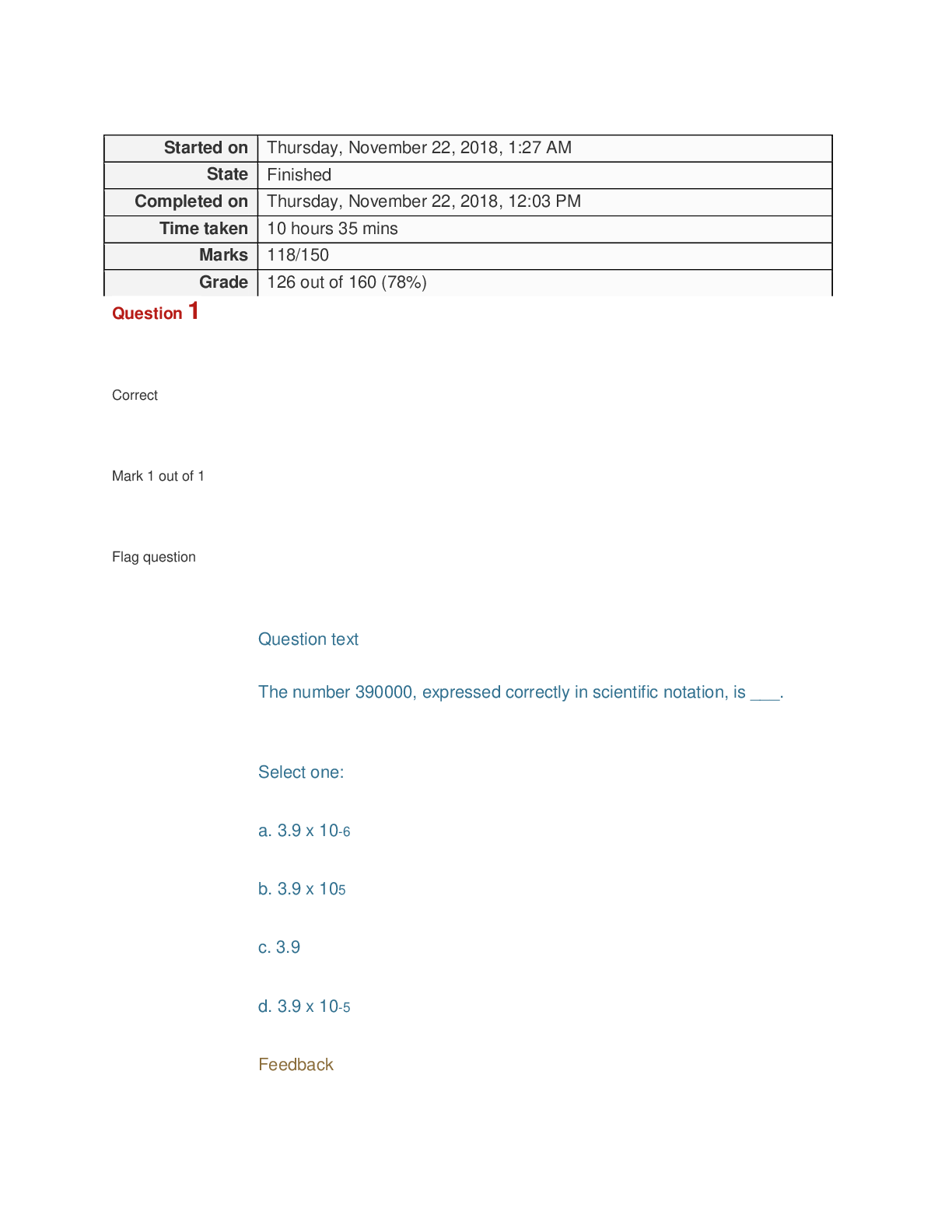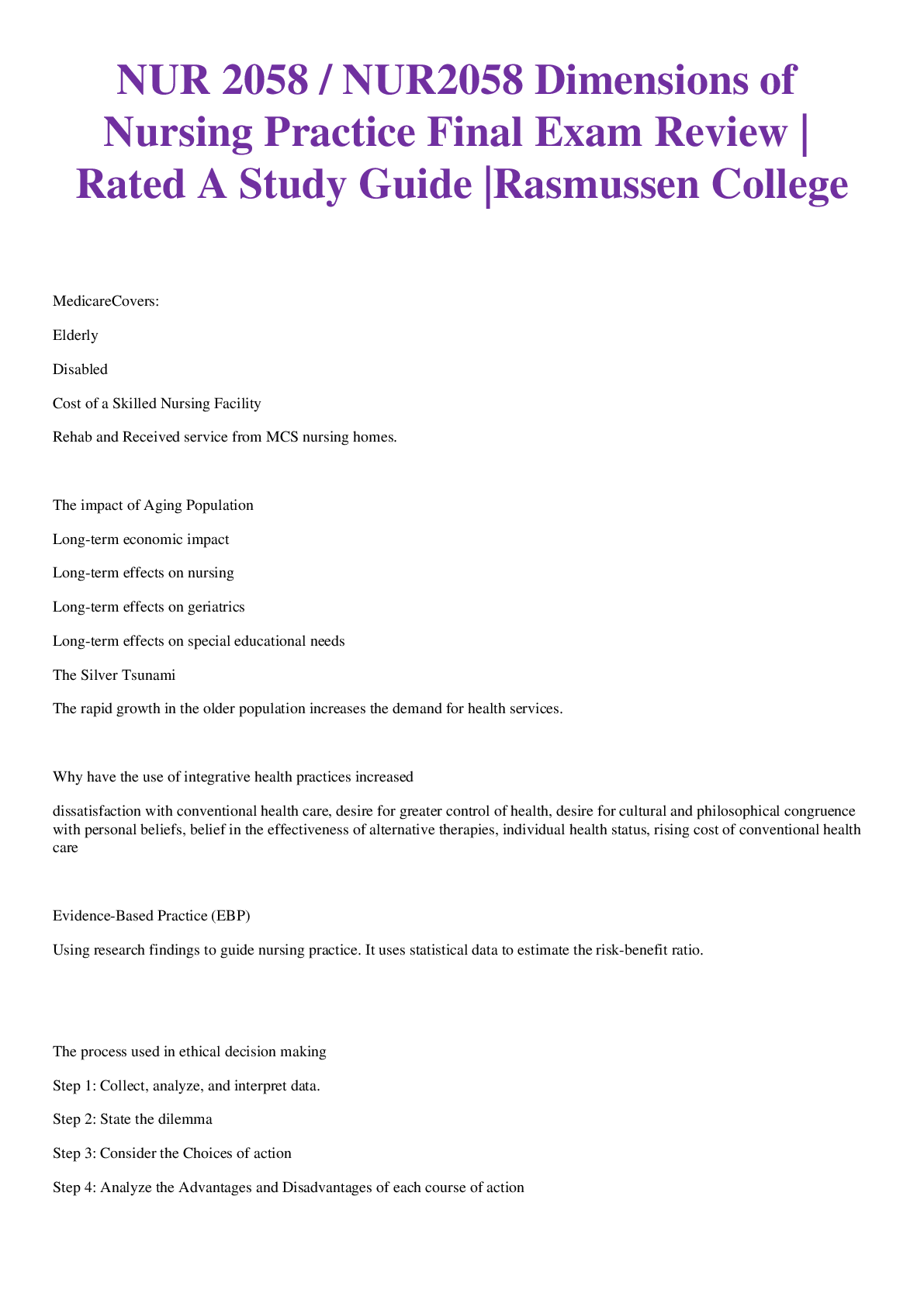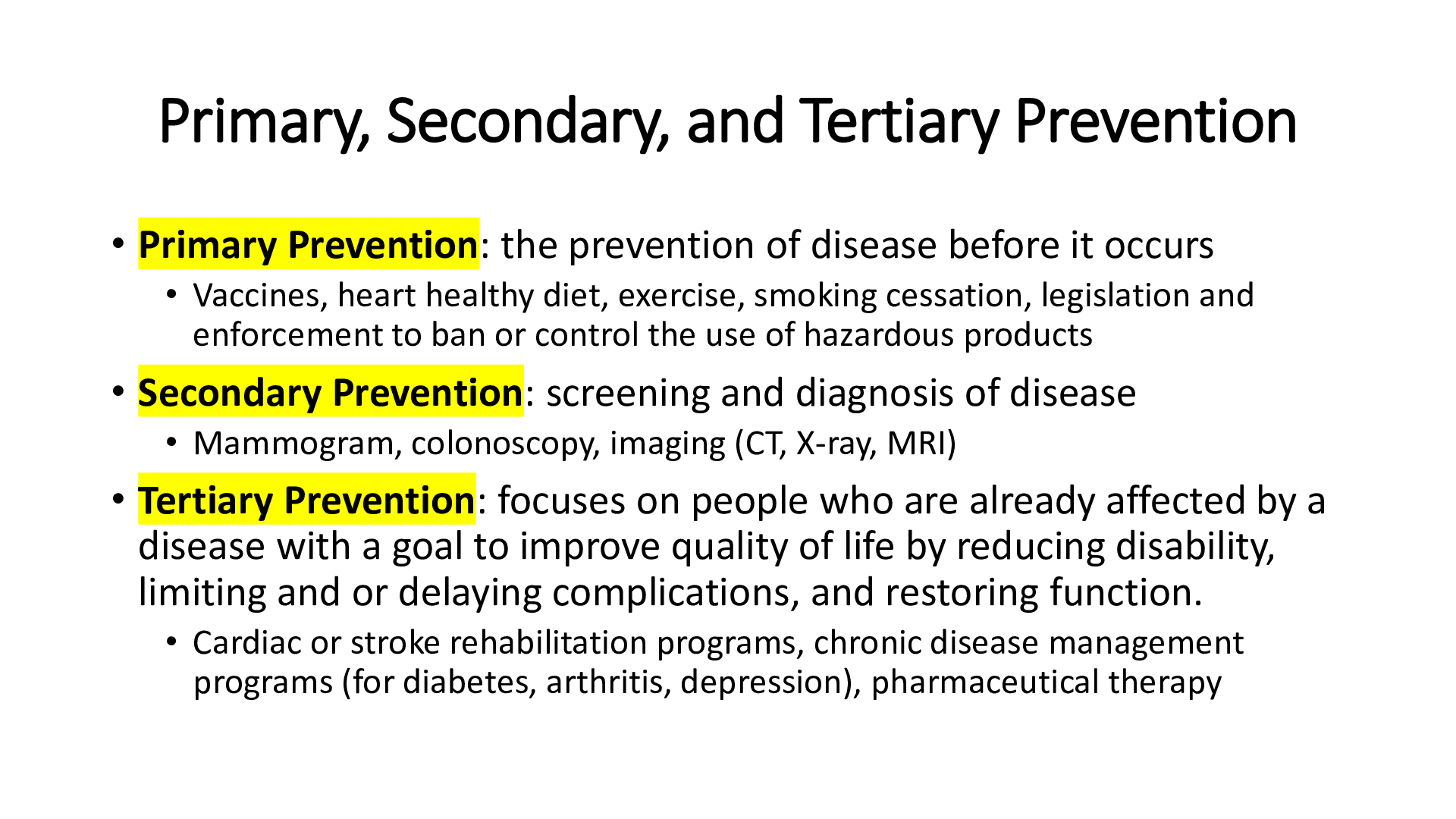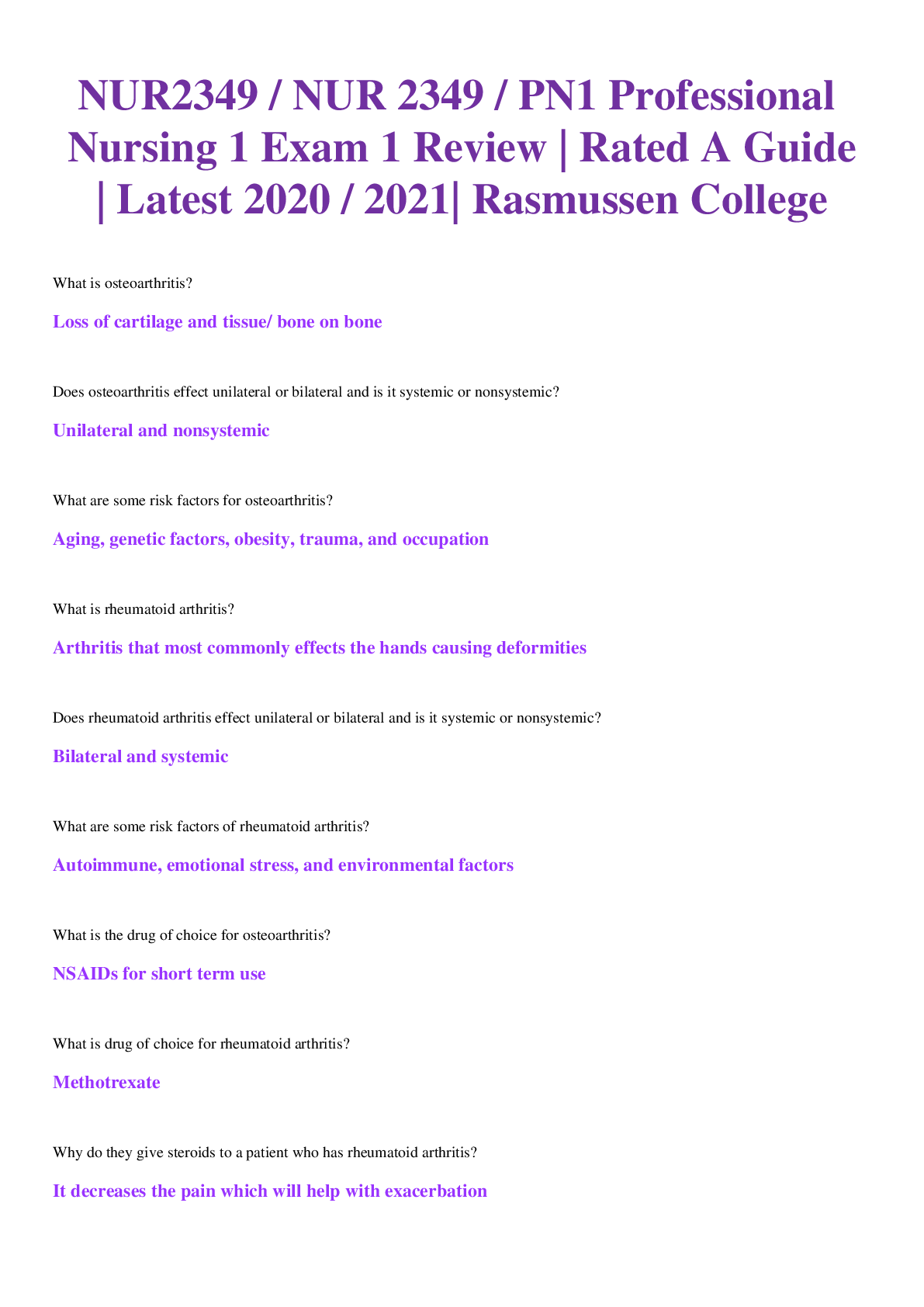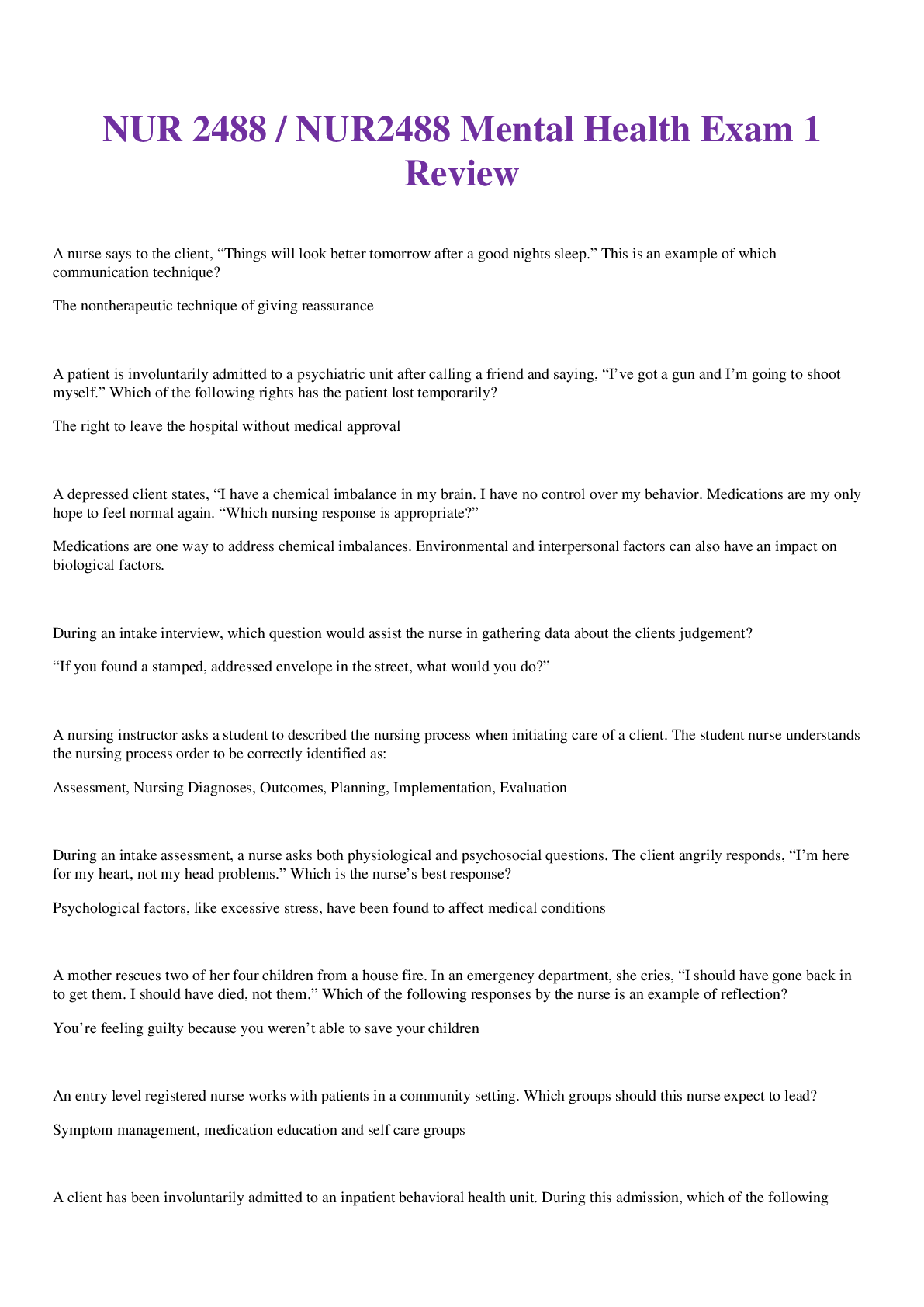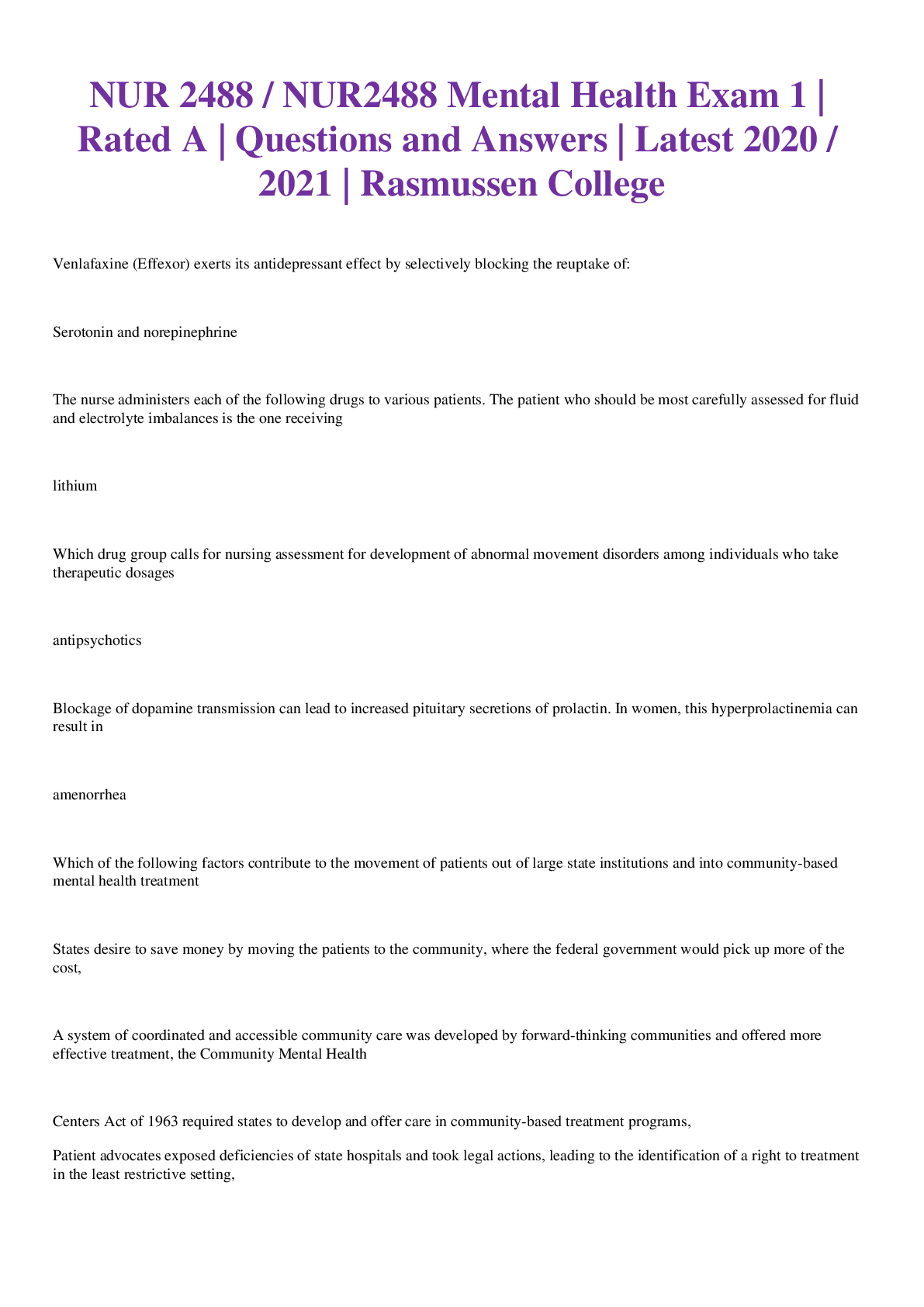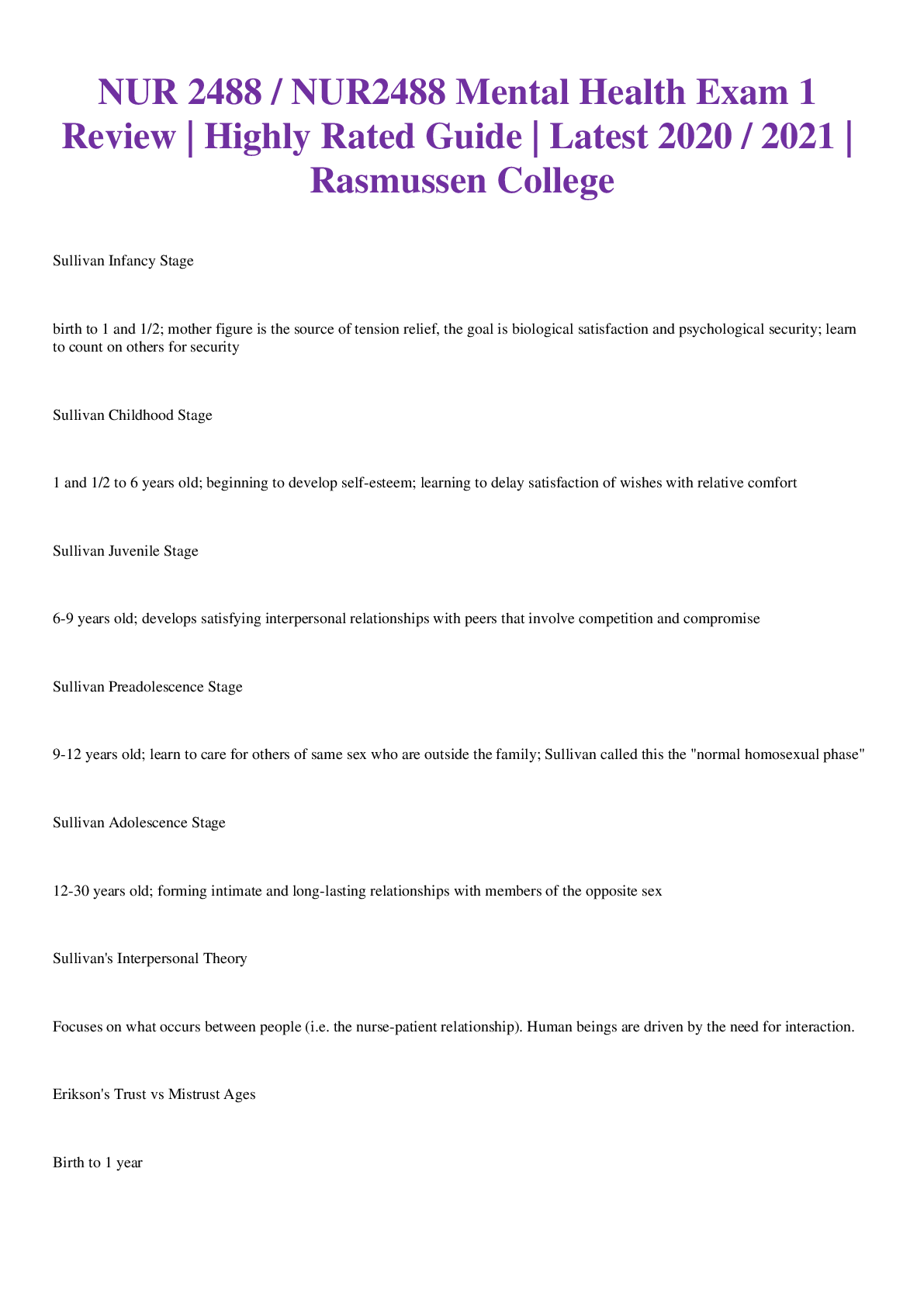*NURSING > EXAM REVIEW > MN580 PEDIATRIC FINAL EXAM: |Latest-Update, 100% Correct Graded A+ (All)
MN580 PEDIATRIC FINAL EXAM: |Latest-Update, 100% Correct Graded A+
Document Content and Description Below
Test 1 • Postpartum Assessment and Adaptation • Normal Newborn Assessment and Care • Birth Process and Electronic Fetal Monitoring • Maternal Adaptation Postpartum Adaptation and Nursing ... Care: Perry Chpts. 18-21 and Chpt. 5 pgs. 119-135 • Physiological adaptations of the postpartum period to implement a nursing plan of care for the postpartum patient ◦ Postpartum period • Defined: fourth trimester, last 6-8 weeks • A period of physical and psychological change • Varies with each person • Begins with delivery of the placenta • Return of all systems to (nearly) pre-pregnant state ◦ Physiologic changes and assessment • ** Bleeding is the most problematic effect of birth • Vital signs - body is going through an initial"shock"/inflammatory process to begin with ▪ Blood pressure • BP should not fluctuate too much during pregnancy… • What's the patients baseline? • Should notfluctuate beyond 30mmHg • Vaginal delivery: up to 500mL of blood loss • C-section: up to 1000 mL of blood loss • BP should not change after birth either unless blood loss is greater than those numbers • Decrease with blood loss ▪ Pulse • Increase with blood loss • Systemic circulation still in effect from being pregnant with increase of stroke volume - heart rate goes down • Should be concerned with anything less than 50 bpm ▪ Respirations • Should be normal after delivery, no baby pushing on diaphragm anymore…12-20 • Watch for patients who've had narcotics/PCA pump ▪ Temperature • Temperature may be slightly elevated but shouldn't be elevated past 24 hours • "normal" high is 100.4 • Watch for signs of dehydration,temp increases with dehydration ▪ Pain • Depends on the patient… • Depends on type of delivery • Surgical incision? Epidural? Natural birth? ▪ Affects of anesthesia • When can they move their extremities? • Spinal headaches from epidural? • Numbness and tingling that won't go away? • Fall risk! • Can have orthostatic hypotension first time getting up ▪ Safety precautions • Fall risk with epidurals • Reproductive ▪ Uterine involution • The uterus has to shrink and go back down to its natural spot after labor - during pregnancy, it gets pushing up to the xyphoid process (diaphragm) • Uterus is a muscle • Bigger babies stretch it out…2 • Immediately after delivery of the placenta • Muscle fibers have stretched and now they need to go back • Inside of uterus looks like a wound...needs to heal • Goes down 1 cm or 1 finger breadth per day • After pains • Pain cause by the uterus shrinking/contracting • Depends on the patient • More pain related to having a big baby and/or having multiple babies • Affected by hormone release • Oxytocin released to stimulate uterus to contract • Breast-feeding increases oxytocin release causing uterus to shrink quicker and heal quicker • Follicular stimulating hormone goes up • Progesterone goes down • Rate is affected by several factors3 ▪ Lochia • Takes about two weeks for uterus to go down • Day 1 post delivery: top of uterus is at the umbilicus • Oxytocin release… • Diabetic? • Type of deliver • Endometrial sloughing can last up to 6 weeks • Amount, color, odor, and consistency is important • Days 1-3: Active bleeding blood - bright red • Lochia rubra • Day 4-10: changing to pinkish color • Day 10-6 weeks: alba (whitish creamy color) • Should not be saturating pads within an hour • Saturated pad = poorly healing uterus, not contracting the way it needs to • Activity may cause heavier bleeding… • Should smell like blood • Should not be excessively clotted blood • Little ones are ok, no bigger than a plum though • Clots indicate blood is pooling somewhere and too much bleeding ▪ Cervix • Dilated after birth but closes rapidly, within one week • External os (opening) - slit appearance instead of round • Lacerations may be source of bleeding with firm uterus ▪ Vagina • Takes 6 weeks to heal • Edema and lacerations may be present • May be small lacerations in the vaginal wall causes some bleeding • Decreased estrogen = vaginal dryness - dyspareunia • Breastfeeding delays ovulation ▪ Perineum • Offer the pt dermaplast • Numbing benzocaine spray • Hemorrhoids… • Depending on the degree of the tear, can be problematic based on location next to anus • Episiotomies and tears (lacerations) • 1st degree • superficial • 2nd degree • Tear goes into the muscle • 3rd degree • Tear goes into the rectal sphincter • 4th degree • Tear goes into the rectum • Use READA: • Redness • Edema • Cold compresses to decrease inflammation • Cold for 24 hours then heat after for circulation • Cultural beliefs come into play • Need to keep area clean and dry • Ecchymosis • Need to be sure that there's no hematoma • Some bruising normal • Discharge • Approximation • Breast • Cardiovascular/blood values ▪ Increased diaphoresis • Sweat profusely, normal - body's response to getting rid of excess fluid ▪ Increased WBC count ▪ Thromboembolism risks • Clotting factors increase during pregnancy • Body is preparing itself for bleeding… • Pts are more prone to DVTs… • Clotting factors decrease after delivery, more at risk for DVT's • Need SCD's • Lovenox • Ted hose • Respiratory ▪ Should become easier after labor, baby no longer pushing up on diaphragm4 • GI/Urinary ▪ Immediate resumption of active digestion (cesarean exception) • Watch for bowel sounds and increase diet as tolerated for cesarean-sections ▪ Constipation may occur ▪ Proteinuria ▪ Urinary retention & Urinary incontinence • After c-sections pts may have urinary retention • 6-8 hours need to void… • Measure at least the first 3 voids, make sure they're emptying their bladder completely and at least 150 mL per void • Body is going through a diuresing process - sweating, urinating… ▪ Risk for infection • WBC count is elevated after delivery - not the best indicator for infection • Integument /Musculoskeletal ▪ Muscle aches • Muscles have been stretched and pulled ▪ Diastasis recti • Abdominal muscles separate where baby has been growing • Depends on how fit/toned the mom was prior to being pregnant ▪ Linea nigra/stretch marks • Linea nigra: Black line that goes down the middle of the abdomen, goes away • Stretchmarks don’t go away, hereditary • Neurological ◦ Postpartum pain management ◦ Maternal complications • Prevention • Observe the patient ▪ Monitor vitals every 15 minutes for the first hour and then every 4 hours after that • Teach the patient of norms and non-norms • Etiology and pathophysiology of postpartum complications and the required nursing care and preventative measures ◦ Postpartum complications • Sub-involution ▪ Common cause is retained placental tissue • Something is in the way and not letting the uterus go down the way it needs to ▪ Pooling or heaviness in the uterus… ▪ Uterus should not be palpable after 14 days ▪ Instruct patient on normal patterns of bleeding or signs of uterine infection • Hypovolemic shock ▪ Bleeding too much ▪ Signs may be delayed ▪ Note any mild tachycardia or hypotension • Monitor vital signs ▪ Note skin color changes ▪ Monitor uterus closely ▪ Note any increase in anxiety • Postpartum hemorrhage ▪ Assess what the patients baseline is, know their risks, how many babies have they had? What's their history? Are they having a section? Was it a big baby? ▪ Medications (for both early and late hemorrhages) • Administer exogenous oxytocin, called pitocin • Dilute in IV bag • 20 milliunits given through IV • Every section patient gets it, risk for increased bleeding, given so uterus heals quicker and contracts more so you don’t bleed • Uterus gets tired from contracting, gets soft - have to administer methergine, stimulates uterus to contract to control hemorrhage - given IM • 0.2 mg dose, max of 5 doses • Side effect: hypertension, cannot give to patient with elevated BP • Pain increases, lots of cramping • Hemabate (carboprost) • Induces contractions to stop bleeding • 0.25 mg every 15 minutes, IM max of 8 doses or 2 mg • Prostoglandin • Cytotec (misoprostol) • 800-1000 mcg rectally • Prostaglandin • Causes diarrhea ▪ Early hemorrhage • Within the first 24 hours of labor ▪ Late hemorrhage • Any time after first 24 hours of labor5 • Thromboembolic disease ▪ DVT • Increased clotting factors during clotting factors during pregnancy • Look for redness, pain, swelling, check pulses in extremities • Any sharp pains in legs? ▪ Superficial venous clots • Postpartum infections ▪ Endometritis • Inflammation/infection in the inner lining of the uterus • Look for pain, fever, foul smelling discharge ▪ UTI ▪ Mastitis • Inflammation of the breast tissue not the duct • Breastfeeding causes cracks in breasts, allows for entry of bacteria • Prolactin produces milk • May get engorged when mothers decide not to breast feed or if breast feeding and over produce milk • Cabbage leaves dry up the milk, put them on breasts, cold compresses/cabbage leaves • Wear a snug bra, avoid hot showers, avoid breast feeding ▪ Wound infections • Urinary tractinfections • Breast disorders • Pre-eclampsia/eclampsia ◦ Chart review/report • Gravida/para ▪ How many times you’ve been pregnant… ▪ Abortions count ▪ Gravida counts current pregnancy ▪ Para is how many pregnancies you've had that went past 20 weeks ▪ Indicates risk factors • Medical history ▪ BP, respiratory, DM, cardiovascular, STDs?,HIV? • Immunization status ▪ Pregnant people need TDAP immunization every 2 years ▪ Cannot be a live vaccine ▪ Cannot get pregnant for at least 28 days after the rubella vaccine • Rhogam needs ▪ Moms who are RH- with an RH+ baby, then mom will need rhogam ▪ Prevents antibodies from occurring if baby's blood gets into mom somehow ▪ Given at 28 weeks and again within 72 hours of having RH+ baby if mom is RH- • L/D history and complications • Infant status • Allergies • Diet • IV status/voiding pattern • Affectively utilize the nursing process to provide support and enhance the family's transition into parenthood ◦ Psychological adaptation and assessment • For mom: ▪ What to expect ▪ How to cope ▪ What do I do next? • Psychological adaptations: a family centered approach ▪ Assess and promote bonding • Role changes ▪ Observe maternal behaviors ▪ Interactions with family • Bonding behaviors of parents - skin to skin contact promotes bonding with baby • Feedings - breast feeding promotes bonding • Rooming-in: baby doesn’t get separated for any reason unless for a surgery or treatment • Is the family doing loving family behaviors? • Factors affecting family adaptations ▪ Discomfort and fatigue ▪ Support system • Who's going to help? ▪ Knowledge of infant needs ▪ Maternal age • How old is the mom? ▪ Previous experience ▪ Expectations ▪ Temperament: maternal &newborn • Baby easy going or fussy?6 ▪ Other factors • Cesarean birth • Preterm infants • Multiple births • Cultural expectations • Health beliefs • Dietary practices [Show More]
Last updated: 1 year ago
Preview 1 out of 97 pages

Reviews( 0 )
Document information
Connected school, study & course
About the document
Uploaded On
Jun 28, 2021
Number of pages
97
Written in
Additional information
This document has been written for:
Uploaded
Jun 28, 2021
Downloads
0
Views
39

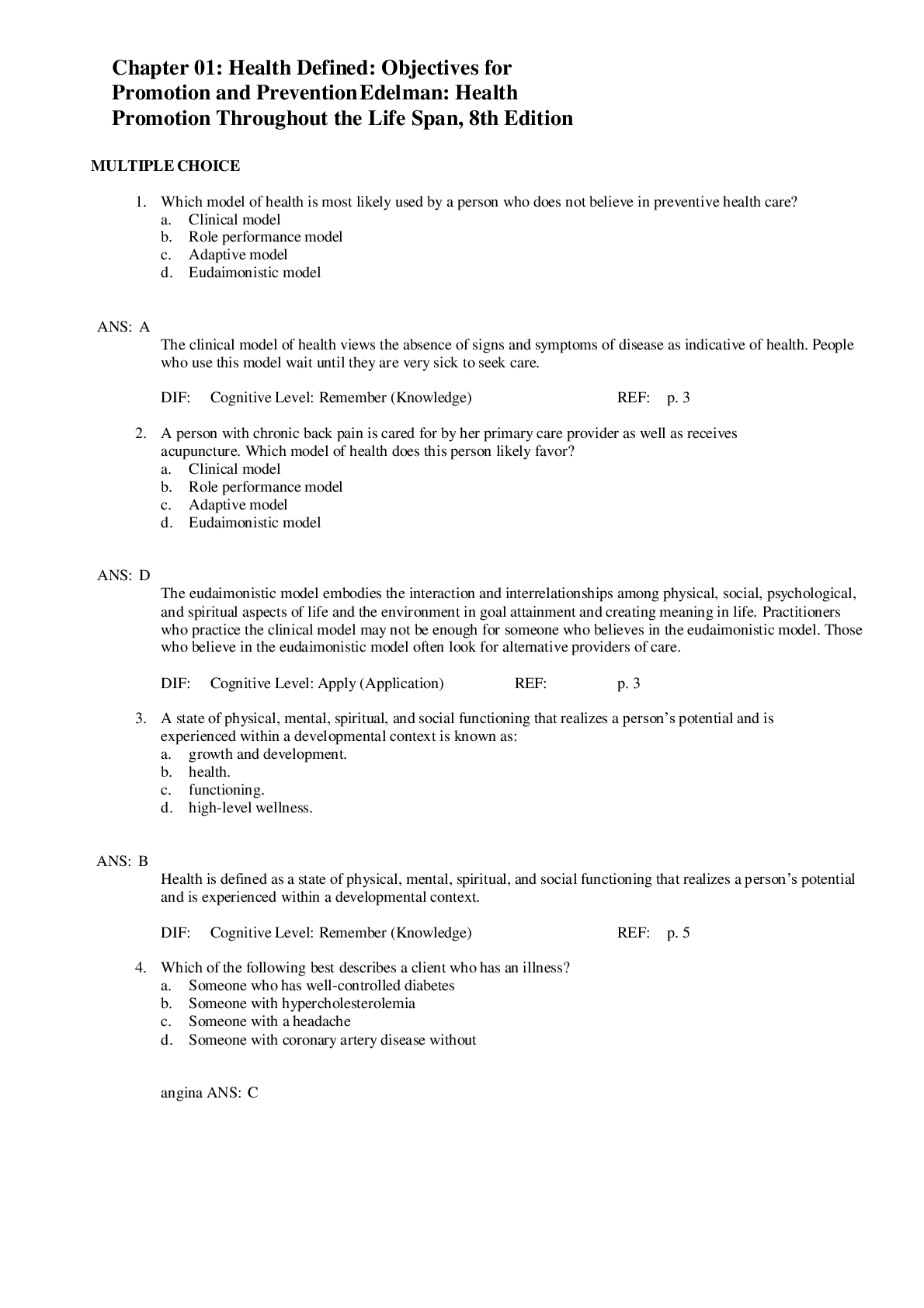

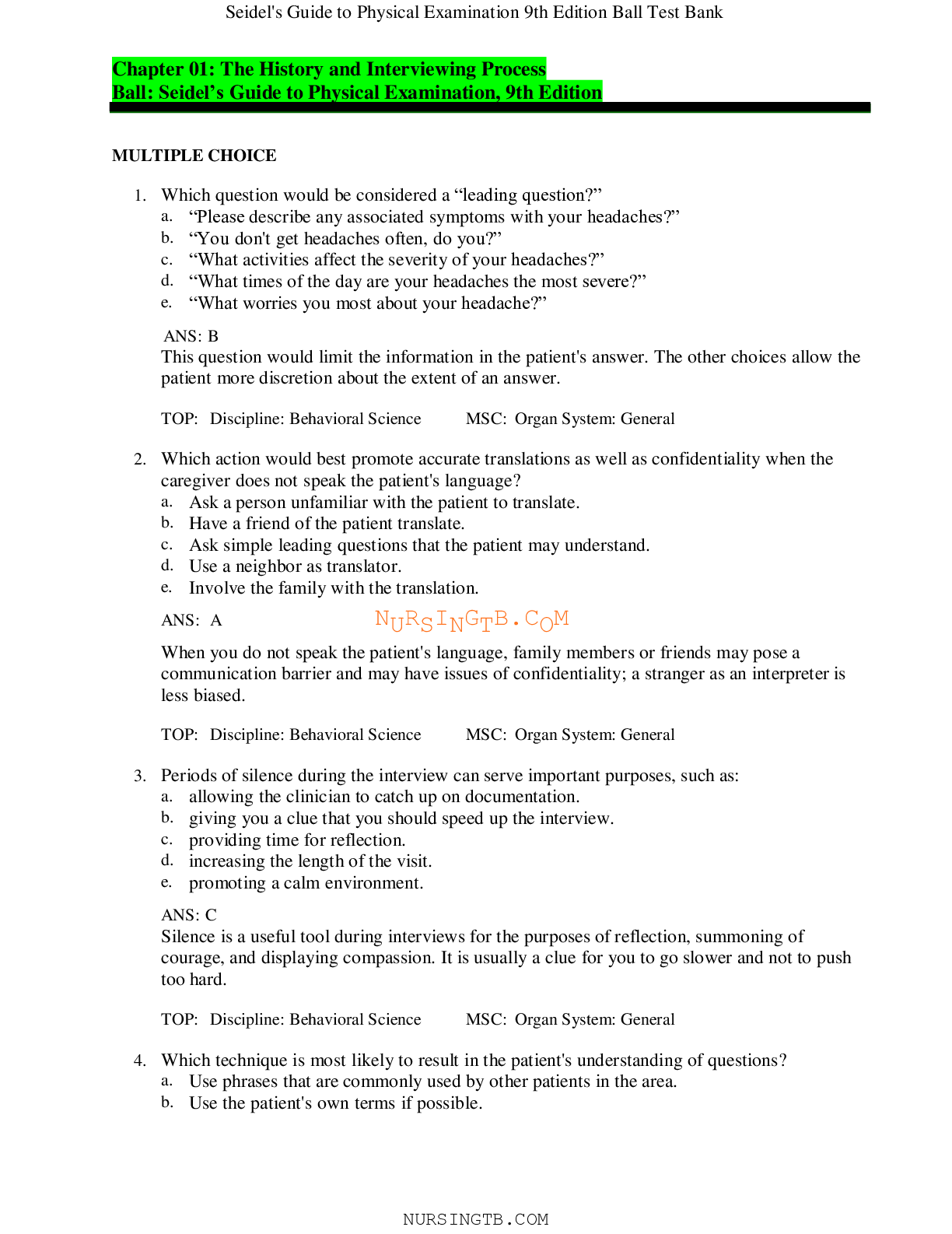
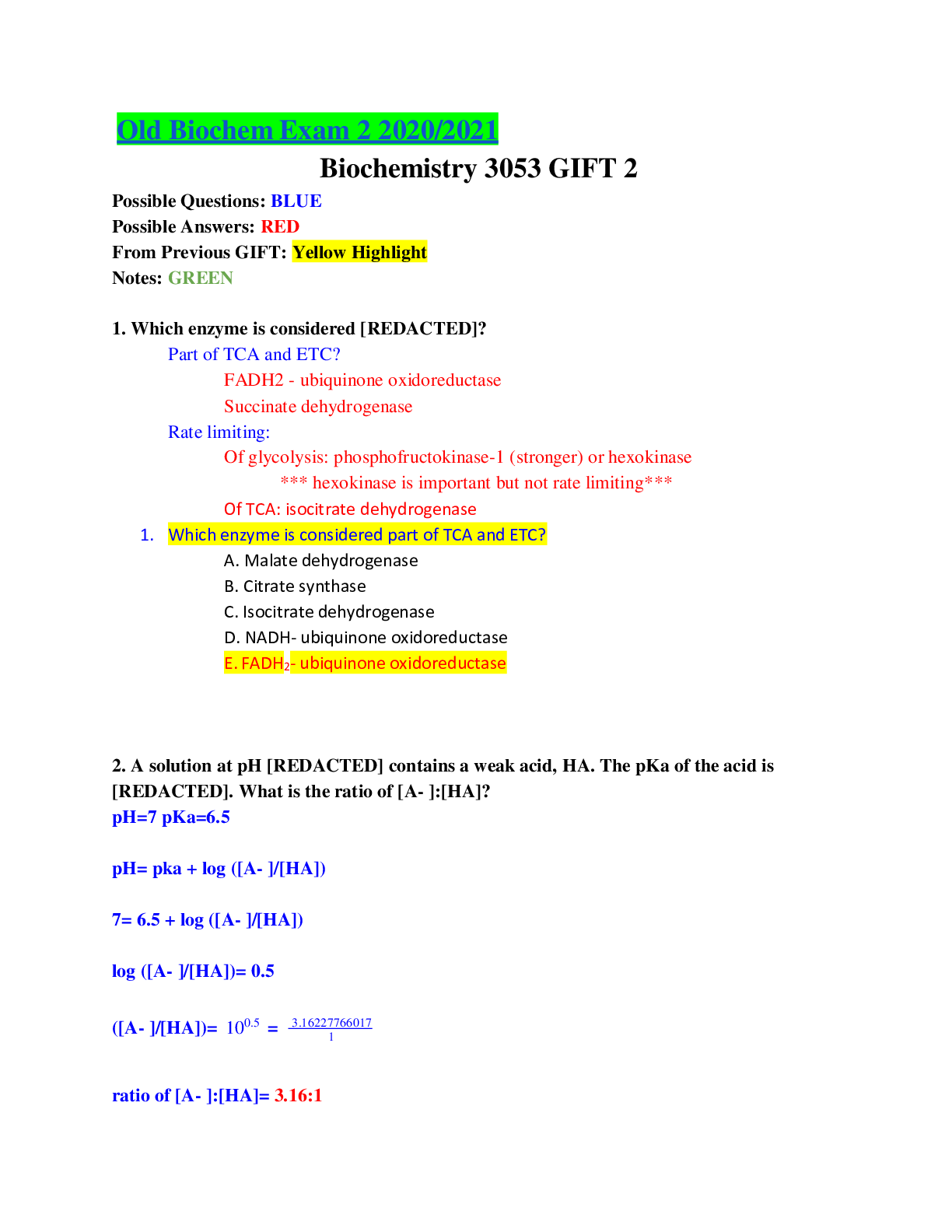
.png)


